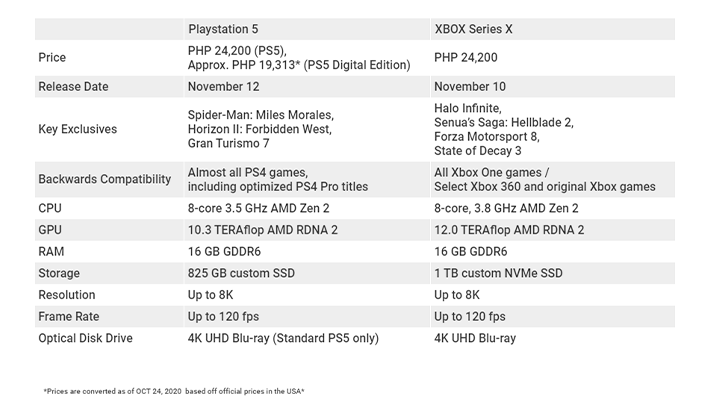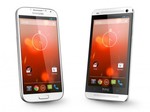Sony PS5 vs Microsoft Xbox Series X - Which One to Consider - Android
If there’s anything we can look forward to this year, it’s the release of the PS5 and XBOX Series X. Both are set to...
The post Sony PS5 vs Microsoft Xbox Series X: Which One to Consider? appeared first on YugaTech | Philippines Tech News & Reviews.
If there’s anything we can look forward to this year, it’s the release of the PS5 and XBOX Series X. Both are set to go live in early November and promise a whole new level of gaming – leaps and leaps further than their older counterparts. But as with all great consoles, there will always be a battle for the crown, and this era’s release couldn’t be more anticipated. In fact, their specifications are likely to rival even those with custom PC set-ups, making it harder to choose, which is the better investment.

So, with the release date looming closer than we think, just which console will be crowned king? Let’s take a look at their specifications and features to see which one can take the crown and be called the gaming console of this generation.
Specifications: The Battle of the Powerhouses
If there’s anything to watch out for, it’s the drive for the pursuit of power. With the introduction of new, better, and more powerful hardware rapidly increasing, developers are rearing their heads to adjust their ambitions and go further than what was foreseen or promised. Ergo, redefining gameplay has never been this monumental or, for that matter, sleeker.


Note: The PH prices mentioned in the table are converted from their US prices as of October 24, 2020.
At the core of this generational shift is, of course, the CPU (Central Processing Unit) and GPU (Graphics Processing Unit). If we were to equate these parts to the human body’s anatomy, the CPU is the heart, and the GPU is the brain. And as with the body, these two need to work in harmony to achieve next-level visuals and performance. Interestingly enough, both Sony and Microsoft have opted to work with AMD to produce these parts.
Equally important is the console’s storage. Both are equipped with an SSD (Solid State Drive) that allows for quicker loading speeds and boot up. But how fast they are is the real question.
For CPU, Sony announced that they would be using a custom third-generation Ryzen Chip (an eight-core 3.5 GHz Zen 2 with AMD’s proprietary 7nm Zen Microarchitecture). As for the GPU, they’re going for a customized version of AMD’s Radeon Navi, highlighted for its capacity to simulate 3D audio and support ray-tracing, as well as its 10.28 teraFLOPs and 36 CUs (Compute Units) at a maximum speed of 2.23GHz. Additionally, it’s packed with a custom 825GB SSD that runs at an amazing 5.5GB per second. And if that isn’t enough, it also allows for additional inserts of extra NVMe SSDs or standard HDDs.

On the other hand, Microsoft is not one to fall behind and has partnered with AMD to co-engineer a custom system-on-chip platform. This means we can expect a more effective integration of both the CPU and GPU for a more stable and increased output. They’ve opted for a similar CPU to the PS5 but one that clocks in a little bit higher at 3.8GHz. Meanwhile, their GPU announcement promises a capacity of 12 teraFLOPs with 52 CUs at a maximum speed 1.825GHz, which allows the Xbox Series X to support hardware-accelerated real-time ray tracing and realistic visuals. In terms of storage and RAM, the console comes equipped with a 16 GB GDDR6 coupled with a 1 TB custom NVMe SSD running at 2.4 GB per second. To expand the storage, you have to purchase an official Xbox Series X Storage Expansion Card that offers an extra 1 TB of space.

With the individual specifications addressed, let’s talk about the actual comparisons and contrasts between the two. While the Xbox Series X might look like the better option with a faster CPU and GPU and higher storage capacity, in reality, it might not be the case. Firstly, in terms of CPU, the gap is too small to push one over the other, and while Microsoft edged it out to a 3.8GHz speed, in reality, it will only manage about 3.6GHz with simultaneous multithreading. So, they’ll probably be similar if not identical in terms of performance. As for the GPU, while the Series X doles out an extra two teraFLOPs, it won’t really make that much of a difference in most games except for its exclusives. After all, it’s now about how many teraFLOPs there are, but how they’re used.
To make matters more complicated, while the PS5 has fewer teraFLOPs (32 CUs), they will be running at 2.23GHz, which is higher than the Series X (52 CUs running at 1.825GHz). Although, it’s only with actual gameplay that we’ll find out which tactic works better since they’re using very different philosophies.
On the topic of SSDs, the PS5’s storage capacity (825 GB) pales compared to the Series X’s 1 TB. However, if we dig a little deeper, PS5 might be going down a different route: quality over quantity. While only allowing for 825 GB of storage, the PS5’s SSDs actually manage 5.5 GB per second, which is double the speed of the Series X’s 2.5 GB per second. This means the PS5 will be significantly faster in terms of loading games. And while they both allow for extra storage inserts, the Series X will only allow official storage cards made for the Xbox.
In terms of resolution and frame rate, both support up to 8K output with a cap of 120fps. Not much can be said in that department as we’re only likely to see the difference when both consoles are put side by side physically.
Design: Geometric vs. Futuristic
Given that these are powerful consoles, we expect equally beautiful designs. However, both developers have opted to go down to a more minimalistic route, choosing cleaner and simpler aesthetics.

With the Xbox Series X, you can expect a more conservative design that resembles a vertical PC tower. Its chassis incorporates a classic black hue with only a small Xbox logo deviating from the solid color scheme. Additionally, the disc drive located in front of the console gives a sleek accent to the chassis’ block style. Ultimately, the geometric design is surprisingly pleasing for something so simply constructed and lends it the versatility to either have it upright or in a horizontal position – perfect for entertainment centers that don’t have enough vertical space.

Contrastingly, the PS5 design, while still on the minimalistic side, has more futuristic influences. It can be said it looks something straight out of the 90’s Mecha anime, Neon Evangelion. Its rounded chassis center is surrounded by two white fins that emanate a soft blue glow in the spaces in between, which give it both subtle elegance and a cyborg-type feel.
Backward Compatibility: Developer Flexibility vs. Software Integration

Inside the Xbox Series X
Both Sony and Microsoft have been more forgiving in lending titles from older generation consoles to their new ones. Although, it looks like the Series X is a little more open to this idea. Not only has Microsoft promised that all Xbox One titles could be played on the Series X, but they have also announced that if you have any Xbox One game that is also available on the Series X, you will get the Series X version once you upgrade consoles. Also, selected titles from the Xbox 360 and original Xbox will be made compatible with the new console. But, the best part about Microsoft’s openness to backward compatibility is their commitment to remastering a few favorite titles, meaning they can run 4K at 120 fps.

Teardown of the Sony PS5
In contrast to Microsoft, Sony has taken a less definitive approach. Instead of upscaling older titles, the PS5 will have built-in software to run PS4 games. While this may allow a few enhancements to be made in the software itself, it’s likely to turn out a little unreliable as not every title is guaranteed a smooth integration. Unfortunately, anything before the PS4 will not be made compatible with the PS5. This means none of our favorite titles from the PS1, PS2, and PS3 can be played on the new-generation console. Not that this is really all that surprising as Sony never promised backward compatibility as a feature on any of their consoles. In fact, the built-in software for PS4 titles lends a little more generosity from Sony than what we initially thought.
Final Thoughts
In the end, we can’t really say which console deserves the crown as we’re only relying on information released. We have to wait for a physical side by side comparison to fully understand the full experience and minute subtleties that both consoles have to offer. And while the Xbox Series X looks slightly better, based on the specifications and backward compatibility, the PS5 could surprise us with its faster loading speeds and other details overlooked. What we do is that both are equally promising and have the potential to redefine gameplay as we know it. Let’s hope to get our hands on one soon as pre-orders fill up way too fast. We’ll get a better idea once we get their official SRPs when they launch in the country in the next few months.
The post Sony PS5 vs Microsoft Xbox Series X: Which One to Consider? appeared first on YugaTech | Philippines Tech News & Reviews.
29/10/2020 09:32 AM
Microsoft joins AI Pilipinas Coalition
29/10/2020 06:18 AM
65-inch Smart TVs under PHP 50,000
29/10/2020 09:03 AM
Sony BRAVIA 85Z8H Android TV now official
29/10/2020 06:18 AM
Kickstart holiday shopping with realme’s Special Bundle promos
29/10/2020 01:41 PM
- HEALTH
- Comics
- Libraries & Demo
- Sports Games
- Racing
- Photography
- Transportation
- Media & Video
- Sports
- Health & Fitness
- Weather
- Medical
- Cards & Casino
- Arcade & Action
- Personalization
- Social
- Communication
- Productivity
- Casual
- Shopping
- Tools
- Brain & Puzzle
- Business
- News & Magazines
- Finance
- Lifestyle
- Music & Audio
- Entertainment
- Travel & Local
- Books & Reference
- Education










